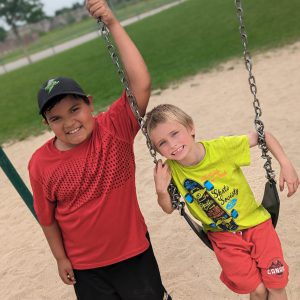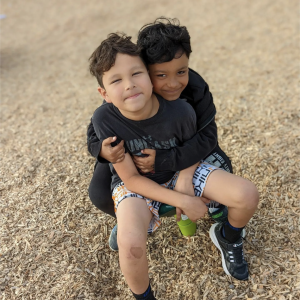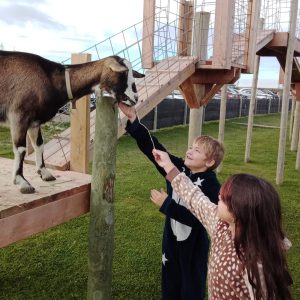









Here at SKCC we believe in Diversity and Inclusion. We also believe that children learn the best through play and risky play. We determine which activities and play experiences to provide using emergent curriculum. Within our emergent curriculum, we cover each of the child’s developmental domains (Physical, Cognitive, and Social and Emotional). In addition, we also incorporate schemas and STEAM into our curriculum.
We at Stanley Knowles Children’s Centre strongly believe that our centre should be a reflection of the diverse country we live in. Children, families, and staff should be able to see pieces of themselves in our environment and our programming. The families at our Centre come from many different backgrounds and reflect a wide variety of cultures, languages, lifestyles, and life experiences. We continuously work to educate one another and provide experiences that will help children celebrate and appreciate the similarities and differences of their peers. Our intention is to provide an environment where children feel seen and accepted for who they are and what they look like. We encourage families to be open in sharing traditions and cultural practices that are important to them. By embracing one another the bond between families, children, and educators are strengthened.
Inclusion Policy: All children and their families are welcome at SKCC regardless of ability, need, background, religion, gender, or economic circumstances. We aim to provide an inclusive environment in which all feel a sense of security and belonging and where our differences can be shared and celebrated. We work together with parents/guardians and professionals to create developmentally appropriate goals for children with additional support needs. An inclusion Specialist is on staff to provide support and knowledge to both staff and families. We welcome all families to share their way of life with us and we value the authentic exposure to diversity that this provides for our centre.
Simply put, emergent means planning activities and experiences based on the children’s emerging interests. We determine what the children’s emerging interests are by observing their play, documenting our findings, and then implementing activities and experiences that relate to those interests.
There are many ways to observe which interests are emerging. The most common practice we use is called webbing. We use webs to generate ideas that we believe are related to that interest. Once we identify an interest, we place that interest in the center of the web. From there, we dissect the interest into three of four categories that we believe are the reason why the children are really into that interest. We then add activities to those categories and implement them into our curriculum.
After we implement activities, we may see that interests change. When this happens, we make a new web based around the new interest and repeat the process. We call this scaffolding.
STEAM is an acronym for Science, Technology, Engineering, Arts and Math. These are all areas of learning that are essential for children to achieve a safe, healthy and comfortable future. STEAM makes thinkers, inventors, innovators, doers, creators and problem solvers. Exposing STEAM to children today will set a foundation for their higher learning tomorrow.
A schema is a line of thought that is demonstrated through play. A schema is both the category of knowledge as well as the process of acquiring that knowledge. Children are constantly adapting to the environment as they take in new information. Jean Piaget (renowned psychologist that specializes in child development) called the schema the basic building block of intelligent behaviour – a way of organizing knowledge. It is useful to think of schemas as “units” of knowledge, each relating to one aspect of the world, including objects and abstract concepts.
Examples of schemas:
Schemas may vary from child to child and at times may be very obvious. Schemas become stronger through active exploration, movement, thinking and investigation. By observing and documenting what the children are doing, it allows us to understand what schema they are interested and we can provide materials to further build on their exploration.
Risky Play may be scary to parents/guardians when you hear it without explanation. Risky play can be very beneficial to children’s overall development. It helps children further all aspects of development, without even knowing how great it is for them! Like mentioned above, it can be frightening to some; with rules, guidelines, and a reasonable “comfort zone” risky play can be done safely.
It is such an important component of children’s lives, and whether we permit it or not, children will find a way to do it or do it behind our backs. If we embrace risky play by teaching and supervising children we can definitely ensure their safety while furthering their development. There are so many benefits to risky play. Most times, children only do what they are comfortable with. Children also learn their limits when you give them the opportunity to try. Children are given a sense of accomplishment when they succeed, which provides them with an intrinsic reward.
Allowing risky play allows us to teach children how certain situations can be made safer while still being enjoyable.
There are six ways children can engage in risky play:
Every individual has their own level of comfort, this goes for children and adults. Typically speaking, individuals will not exceed their comfort zone unless they feel ready for the challenge and are prepared to do so.
Cause & effect—what happens when children do something, and why
Attention—focusing on the task at hand, concentrating on the goal/challenge
Rules—respecting, understanding and acknowledging the rules that have been put in place, they are usually there for a reason (this comes back to “comfort zone” & overall safety of the children)
Concepts— terms such as winning & losing can be hard for children, this gives us an opportunity to further explain and use examples
Body awareness—being aware of their body & surroundings to ensure everyone’s safety
Divergent thinking—being creative with the risk & ultimately having fun!
Social interaction—involving other children in challenging themselves, children will be interested in what is going on & why
Self-awareness—knowing what your limits are & when the challenge is too much (if they are not ready for it), expressing their emotions
Cooperation—children working together to create a fun, safe AND challenging environment
Gross & fine motor skills—using their large & small muscles to challenge themselves
Communication—letting staff & other children know how they feel about the situation; was it exciting? Was it too much for them?

Programming based on your child’s interests

Dedicated and Nurturing Early Childhood Educators

Works in partnership with the community and École Stanley Knowles School

Inclusive of all families
Hours of Operation: Monday – Friday 7:00 am – 5:30 pm